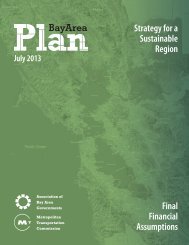Draft
Strategy for a Sustainable Region Priority ... - One Bay Area
Strategy for a Sustainable Region Priority ... - One Bay Area
- No tags were found...
You also want an ePaper? Increase the reach of your titles
YUMPU automatically turns print PDFs into web optimized ePapers that Google loves.
Figure 26<br />
PDA Readiness Criteria Worksheet<br />
PDA name: San Francisco Downtown-Geary-Van Ness Version: Amended<br />
#<br />
Readiness<br />
Criteria Category<br />
# Sub-Criterion Name Present (2012)<br />
PDA Development Readiness Scoring<br />
2020 2030 2040 Notes<br />
A<br />
PDA Housing<br />
Capacity<br />
Estimate<br />
1 Estimate of current local land use policy<br />
new housing capacity<br />
16,846<br />
Figure based on 2012 soft site survey from City; identified 1,415<br />
underutilized sites summing to 221 acres (average under 7K SF<br />
sites) achieving average density of 76 DUs/acre; 2010 survey<br />
showed 2035 buildout would be just 10,400 more than 2010 existing<br />
units; 2007 Housing Element showed room for 9,545 RHNA units (all<br />
incomes) in PDA<br />
2 Plan Bay Area new housing allocation<br />
3 Capacity surplus or (shortfall) (10,293)<br />
27,139<br />
The increment of new housing allocated to the PDA in Plan Bay<br />
Area<br />
Difference between estimated housing capacity (2012) and allocation<br />
A-77<br />
4 Estimated increased capacity through<br />
likely changes to land use policy,<br />
including any initiative-based density<br />
restrictions (percentage change to<br />
existing capacity)<br />
0% 25% 50%<br />
Plans for PDA include Downtown Plan (1980s), Van Ness Area Plan<br />
(1980s), Rincon Hill Plan (2005), Western SOMA (to be adopted<br />
2013), Chinatown, Civic Center, Northeast Waterfront Plan, Central<br />
Corridors Plan (to be done in next couple years, with potential<br />
upzoning). City has shown history of successful upzoning around<br />
Downtown (e.g. Rincon Hill and TCDP). EPS assumes some current<br />
soft sites will be redeveloped prior to future upzoning, while other<br />
sites will become "soft" when allowable densities are increased.<br />
Amendment assumes more aggressive upzoning.<br />
5 Estimated gross housing capacity at<br />
each period 16,846 21,058 25,269<br />
6<br />
Sum of Capacity Constraint<br />
Coefficients<br />
0.45 0.20 0.15<br />
Major growth requires redevelopment of existing uses on many very<br />
small lots. Near-term challenges include lack of environmental<br />
clearance for larger projects and social conditions in Tenderloin and<br />
Mid-Market areas. Longer-term challenge includes need for major<br />
circulation improvements to facilitate growth, though values can<br />
support substantial costs.<br />
7<br />
EPS estimate of housing production<br />
given constraints<br />
9,265 16,846 21,479<br />
Pace of development likely to slow over time as most sites are<br />
physically challenging and easiest sites will be developed first.<br />
8<br />
Percentage of PDA 2040 housing<br />
allocation accommodated<br />
34.1% 62.1% 79.1%<br />
Market is very strong but physical capacity of sites individually and in<br />
aggregate represents a significant constraint on development.<br />
Amendment assumes more aggressive upzoning, regional funding<br />
for transportation and other infrastructure, and restoration of<br />
Redevelopment-type powers to assist with parcel assembly.<br />
Economic & Planning Systems, Inc. 3/26/2013 Page 1 of 4 P:\121000\121113MTC\Readiness_Assessment Process\PDA Readiness Assessment\DS_Readiness Assessment_032513




